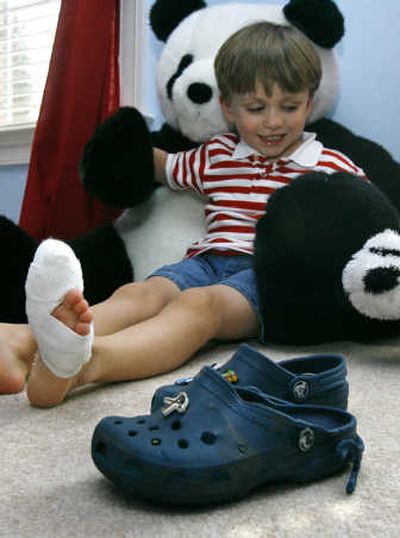Crocs concerns are rising

WASHINGTON – At rail stations and shopping malls around the world, reports are popping up of people, particularly young children, getting their toes caught in escalators. The one common theme seems to be the clunky soft-soled clogs known by the name of the most popular brand, Crocs.
One of the nation’s largest subway systems – the Washington Metro – has even posted ads warning riders about wearing such shoes on its moving stairways. The ads feature a photo of a crocodile, though they don’t mention Crocs by name.
Four-year-old Rory McDermott got a Croc-clad foot caught in an escalator last month at a mall in northern Virginia. His mother managed to yank him free, but the nail on his big toe was almost completely ripped off, causing heavy bleeding.
At first, Rory’s mother had no idea what caused the boy’s foot to get caught. It was only later, when someone at the hospital remarked on Rory’s shoes, that she began to suspect the Crocs and did an Internet search.
“I came home and typed in ‘Croc’ and ‘escalator,’ and all these stories came up,” said Jodi McDermott, of Vienna, Va. “If I had known, those would never have been worn.”
According to reports appearing across the United States and as far away as Singapore and Japan, snags occur because of two of the biggest selling points of shoes like Crocs: their flexibility and grip. Some report the shoes get caught in the “teeth” at the bottom or top of the escalator, or in the crack between the steps and the side of the escalator.
The reports of serious injuries have all involved young children. Crocs are commonly worn by children as young as 2. The company introduced shoes in its smallest size, 4/5, this past spring.
Niwot, Colo.-based Crocs Inc. said it does not keep records of the reasons for customer-service calls. But the company said it is aware of “very few” problems relating to accidents involving the shoes, which are made of a soft, synthetic resin.
“Thankfully, escalator accidents like the one in Virginia are rare,” the company said in a statement.
In Japan, the government warned consumers last week that it has received 39 reports of sandals – mostly Crocs or similar products – getting stuck in escalators from late August through early September. Most of the reports appear to have involved small children, some as young as 2 years old.
In Singapore, a 2-year-old girl wearing rubber clogs – it’s unclear what brand – had her big toe ripped off in an escalator accident last year, according to local media reports.
And at the Atlanta airport, a 3-year-old boy wearing Crocs suffered a gash across the top of his toes in June. That was one of seven shoe entrapments at the airport since May 1, and all but two of them involved Crocs, said Roy Springer, operations manager for the company that runs the airport terminal.
The U.S. Consumer Product Safety Commission said escalator accidents caused more than 10,000 injuries last year, but the agency has few records of specific shoe problems. Only two shoe entrapments have been reported by consumers since the beginning of 2006. One reported in May involved “rubber footwear.”
Crocs officials said they were working with the Elevator Escalator Safety Foundation on public education initiatives. But the group’s executive director, Barbara Allen, said that’s not true.
Allen said a Crocs official called her in September 2006 about possible cooperation.